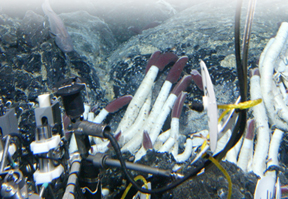
Geotimes Home | AGI Home | Information Services | Geoscience Education | Public Policy | Programs | Publications | Careers

 On this return trip,
the researchers wanted to learn how the original Galápagos vent fields
and their fauna had changed. To their surprise, the most famous and best-studied
vent field in the region, Rose Garden, is now gone. The scientists suspect lava
flows paved over the field. Nearby, a young vent community is claiming residency
with small clams and mussels as well as one-inch long tubeworms growing on larger
tubeworms. Disappointed over the loss of Rose Garden, but hopeful that the young
vent field will develop as a community, the scientists named the new site Rosebud.
On this return trip,
the researchers wanted to learn how the original Galápagos vent fields
and their fauna had changed. To their surprise, the most famous and best-studied
vent field in the region, Rose Garden, is now gone. The scientists suspect lava
flows paved over the field. Nearby, a young vent community is claiming residency
with small clams and mussels as well as one-inch long tubeworms growing on larger
tubeworms. Disappointed over the loss of Rose Garden, but hopeful that the young
vent field will develop as a community, the scientists named the new site Rosebud. |
Geotimes Home | AGI Home | Information Services | Geoscience Education | Public Policy | Programs | Publications | Careers |